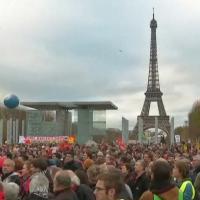
Good response for ideas of CWI
On Saturday, 12 December, the last day of the COP21 proceedings in Paris, people took to the streets in two protest rallies – one from the Arc de Triomphe and one at the Eiffel Tower. There were between 10 and 15,000 on each, protesting at the failure of politicians world-wide to stem the threat of disastrous climate change. These gatherings had the effect of giving the activists the last word on the issue after two weeks of fruitless discussions at the summit itself (see report here).
CWI public meeting
The Red Line Action demonstration organised by ‘350.org’ was banned until less than a day before it was due to take place, so little or no public mobilisation was done. Instead, around ten ‘training sessions’ and briefings were organised inside the activists’ base known as ZAC. About one hundred organisations were backing the demonstration for which everyone was supposed to be dressed in red and carrying red tulips. In the event, once we had all assembled, it looked very effective when several hundred metres of wide red bands of cloth were carried by the demonstrators and laid down on the ground. These were the red lines that must not be passed. Then the flowers were put on the cloth bands – all of this with the Arc de Triomphe in the background.
The colourful display was what is usually seen on environment demonstrations – full of polar bears, maize figures, brass bands, rocking elves, choral groups etc.
Just two days earlier near to the ZAC centre, we had a taste of this creativity when 150 Swedish protesters held a demonstration against the Swedish politicians’ hypocritical role in the climate negotiations. There were four excellent short speeches from, among others, Arne Johansson from Rättvisepartiet Socialisterna (CWI Sweden), representing a strong neighbourhood organisation involved in a battle to stop the Stockholm Bypass motorway.
On December 12, rally number two was also powerful. With the Eiffel Tower as a backdrop, there were people dancing and forming three enormous human chains. At the closing rally, there were speeches from various activists including Naomi Klein, who always describes clearly that it is the big companies and the governments who protest them who are to blame for the lack of control over what happens in society but, apart from suggesting bigger and better protests, does not call for a real (socialist) alternative for planning the future of the planet.
Compared to the climate summit in Copenhagen in 2009, when 100,000 marched, these protests in Paris were, of course, much smaller. Originally, it had been calculated that 400,000 would demonstrate in Paris on 29 November on the climate issue. But, given the state of emergency and the terrorist attacks, it was nevertheless an important victory that demonstrations took place at all.

CWI intervention
There was a team of us in Paris from the CWI in France, England, Belgium, Sweden, the Netherlands and Portugal. We intervened with leaflets and socialist newspapers in some of the major protest gatherings and felt there was a great interest in discussing socialist ideas. While more and more activists agree to system change rather than climate change, too many are still unclear what system to replace capitalism with. At our public meeting on the Friday evening, more than 50 people from 12 different countries attended.
German example
On our way back to Sweden on the ‘climate bus’, there was a lot of discussion about how to continue the struggle. In Sweden, for example, there is the campaign against the Stockholm motorway bypass. Another example is the protests on December 16 in Germany against Deutsche Bahn’s decision to completely cancel the night trains. Naomi Klein has called for a ‘Leap Day’ on February 29 – a global day of protest for the climate.
One of the most celebrated examples in discussions in Paris was "Ende Gelände" – a campaign in August in which 1,500 people took themselves into an open coal mine in Garzweiler in Germany. Many were participating for the first time in such an action. Despite the police’s extreme violence, they managed to stand firm and force a complete standstill in the mining operations. The aim was to focus on what is seen as the German paradox – a country presenting itself as a model for using renewable energy at the same as the exploitation of coal is allowed to continue. On 30 May next year, Ende Gelände is organising a follow-up action.
The struggle must continue to encourage more trade unions and leftist organisations to actively participate in the fight on the climate issue and to transform what sometimes appears to be a bit of a circus into a genuine mass movement for change. It is a long battle but we will win.


Be the first to comment